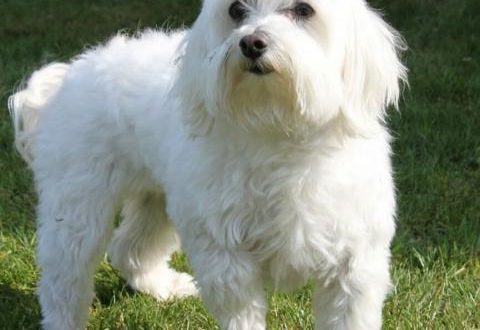
Japanese Spitz
The Japanese Spitz is a small dog from the Spitz group with a fluffy snow-white coat. Representatives of the breed are distinguished by a lively temperament, but they are quite manageable and easily trained.
Contents
- Characteristics of Japanese Spitz
- Basic moments
- History of the Japanese Spitz breed
- Video: Japanese Spitz
- Appearance of the Japanese Spitz
- Photo of Japanese Spitz
- Character of the Japanese Spitz
- education training
- Maintenance and care
- Health and disease of Japanese Spitz
- How to choose a puppy
- Japanese Spitz price
Characteristics of Japanese Spitz
| Country of origin | Japan |
| The size | Average |
| Growth | 25-38 cm |
| Weight | 6–9 kg |
| Age | about 12 years old |
| FCI breed group | spitz and breeds of primitive type |
Basic moments
- In the homeland of the breed, in Japan, its representatives are called nihon supitsu.
- Japanese Spitz are not the most noisy creatures. Dogs rarely bark, moreover, they easily and painlessly give up this habit altogether if the owner so requires.
- Representatives of this breed are very dependent on human attention, but do not suffer from excessive importunity. They willingly contact with people whom they consider members of their family, carefully avoiding strangers.
- Japanese Spitz are extremely neat and even if they get dirty during walks, it is insignificant. Contributes to the preservation of the cleanliness of the “fur coat” and dense integumentary hair of the animal, which has a dust and water repellent effect.
- The Japanese Spitz is very homesick when alone, so he entertains himself with petty pranks, sometimes causing the owner to want to spank the fluffy naughty.
- These dogs are excellent in training, so they are willingly taken to all kinds of circus shows. And abroad, the “Japanese” have been successfully performing in agility for a long time.
- The hunting and stalking instincts of the Japanese Spitz are absent, so they do not see prey in every cat they meet.
- Even if the pet lives in a large family, he will consider one person as his own owner. And in the future, it is this person who will have to take on the duties of training and training the dog.
- The breed is widespread and very popular in the Scandinavian countries, as well as in Finland.




The Japanese Spitz is a snow-white shaggy miracle with a twinkle in his eyes and a happy smile on his face. The main purpose of the breed is to be friends and keep company, with which its representatives cope at the highest level. Moderately inquisitive and emotionally restrained in a good way, the Japanese Spitz is an example of an ideal friend and ally, with whom it is always easy. Mood swings, eccentric behavior, nervousness – all this is unusual and incomprehensible to the playful “Japanese”, born with a strategic supply of positive and excellent mood, which the animal has enough for its entire long life.
History of the Japanese Spitz breed

Japanese Spitz was introduced to the world by the Land of the Rising Sun between the 20s and 30s of the 20th century. The East is a delicate matter, so it is still not possible to get information from Asian breeders about which particular breed gave a start in life to these charming fluffies. It is only known that in 1921, at an exhibition in Tokyo, the first snow-white “Japanese” was already “lit”, whose ancestor, most likely, was a German Spitz brought from China.
Starting from the 30s and up to the 40s of the XX century, breeders intensively pumped the breed, alternately adding to it the genes of spitz-shaped dogs of Canadian, Australian and American origin. It is to them that the Japanese Spitz owes its emphatically glamorous, with a slight bias towards orientation, appearance. At the same time, the official recognition of animals by cynological associations proceeded gradually and not always smoothly. For example, in Japan, the breed standardization procedure was carried out as early as 1948. The International Cynological Association pulled to the last, but in 1964 it still lost ground and offered its own version of the breed standard. There were also those who remained steadfast in their decision. In particular, the specialists of the American Kennel Club categorically refused to standardize the Japanese Spitz,
Japanese Spitz arrived in Russia after the collapse of the USSR together with the circus trainer Nikolai Pavlenko. The artist was not going to engage in breeding activities, and he needed dogs exclusively for performances in the arena. However, after a couple of successful numbers, the trainer had to reconsider his views. So, replenishment from several purebred producers arrived in the family of circus Spitz, who later gave life to most of the domestic “Japanese”.
Curious information: after the appearance on the network of photographs of Philip Kirkorov in an embrace with a Japanese Spitz, there were rumors that the king of the domestic pop scene got a pet from Pavlenko’s troupe. The trainers allegedly did not want to part with their ward for a long time, stubbornly rejecting the generous offers of the star, but in the end they gave in.
Video: Japanese Spitz
Appearance of the Japanese Spitz

This smiling “Asian”, although it seems to be an exact copy of the German and Florentine Spitz, still has some exterior features. For example, compared to its European relatives, it has a more elongated body (the ratio of height to body length is 10:11), not to mention the emphasized oriental section of the eyes, which is atypical for spitz-like dogs. The snow-white coat of the “Japanese” is another identifying feature of the breed. No yellowness and transitions to milky or creamy versions are allowed, otherwise it will not be a Japanese Spitz, but an unsuccessful parody of it.
Head
The Japanese Spitz has a small, rounded head, somewhat expanding towards the back of the head. The stop is clearly defined, the muzzle is wedge-shaped.
Teeth and bite
The teeth of the representatives of this breed are medium-sized, but strong enough. Bite – “scissors”.
Nose
The miniature nose is pointedly rounded and painted black.
Eyes
The eyes of the Japanese Spitz are small, dark, somewhat obliquely set, with a contrasting stroke.
Ears
Tiny dog ears are triangular in shape. They are set at a fairly close distance from each other and look straight ahead.
Neck
The Japanese Spitz has a moderately long, strong neck with a graceful curve.

Frame
The body of the Japanese Spitz is slightly elongated, with a straight, short back, a convex lumbar region and a broad chest. The belly of the dog is well tucked up.
limbs
Shoulders set at an angle, forearms of a straight type with elbows touching the body. The hind legs of the “Japanese” are muscular, with normally developed hocks. Paws with hard black pads and claws of the same color resemble those of a cat.
Tail
The tail of the Japanese Spitz is adorned with long fringed hair and is carried over the back. The tail is set high, the length is medium.
Wool
The snow-white “cloak” of the Japanese Spitz is formed by a dense, soft undercoat and a harsh outer coat, standing upright and giving the appearance of the animal a pleasant airiness. Areas of the body with a relatively short coat: metacarpus, metatarsus, muzzle, ears, frontal part of the forearms.
Color
Japanese Spitz can only be pure white.
Photo of Japanese Spitz
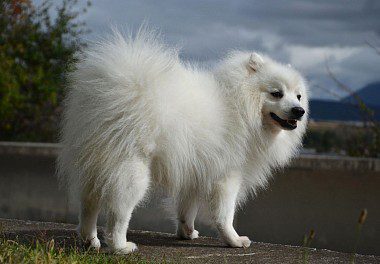
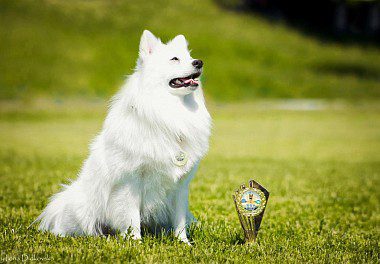

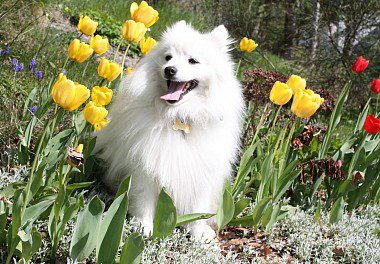

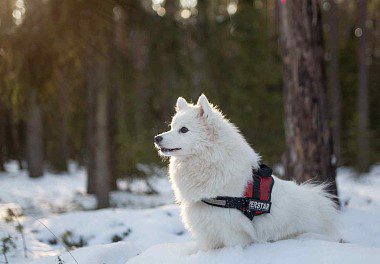
Defects and disqualifying defects of the breed
Defects affecting the show career of a Japanese Spitz are any deviations from the standard. However, most often the score is reduced for deviations from the reference bite, too twisted tails, excessive cowardice, or vice versa – the tendency to make noise for no reason. Total disqualification usually threatens individuals with ears down and a tail that is not carried on its back.
Character of the Japanese Spitz
It cannot be said that these snow-white pussies are Japanese to the marrow of their bones, but they still got a piece of the Asian mentality. In particular, Japanese Spitz are able to correctly dose their own emotions, although the signature smile from ear to ear literally does not leave the dog’s muzzle. Empty talk and fuss among representatives of this breed is an exceptional phenomenon and is not welcomed by exhibition commissions. Moreover, the nervous, cowardly and barking animal is a classic plembra, which has no place in the honorary ranks of the Japanese Spitz.

At first glance, this elegant “Asian” is the embodiment of friendliness. In reality, Japanese Spitz trust only members of the family in which they live, and are not at all enthusiastic about strangers. However, this does not mean that the dog will show its own dislike to everyone and everyone. The correct “Japanese” masterfully hides his dark essence and the negative feelings that overwhelm him. In relations with the owner, the pet, as a rule, is patient and never crosses the cherished line. Do you want to play with fluffy? – Always please, Spitz will gladly support the company! Tired and want to retire? – No problem, imposing and pestering is not in the rules of this breed.
Japanese Spitz easily get along in a dog team, especially if the team consists of the same Spitz. With other pets, dogs also do not have friction. This “clot of fluffiness” effortlessly finds an approach to both cats and hamsters, without trying to encroach on their life and health. Dogs have a fairly even relationship with children, but do not take them as dumb nannies. The fact that an animal endures uncomfortable hugs and other not-so-pleasant manifestations of childish feelings does not oblige it to dissolve in every two-legged creature.
Many Japanese Spitz are excellent actors (the circus genes of the first Russian “Japanese” no-no and will remind of themselves) and even more wonderful companions, ready to follow the owner to the ends of the world. By the way, if you are not too lazy to instill guard habits in your ward, he will not let you down either and will notify you in time of the impending “robbery of the century”.
An important point: no matter how universally charming a pet is, get ready for the fact that from time to time he will “put on a crown” to prove to the world that the spirit of a majestic samurai can hide in a small body. It looks ridiculous, but it is definitely not worth condoning such behavior: there should be only one leader in the house, and this is a person, not a dog.
education training
The main thing in raising a Japanese Spitz is the ability to quickly establish emotional contact. If the dog loves the owner and trusts him, there are no difficulties in training. And vice versa: if the “Japanese” did not manage to find his niche in the new family, even an experienced cynologist will not be able to turn him into an obedient companion. So as soon as a four-legged friend has moved into your house, look for a special key to his heart, because then it will be too late.
Do not confuse warm, trusting relationships with connivance. Undoubtedly, the Japanese Spitz is sweet and charming, but in this world not everything is allowed to him. And since punishment does not pass with these Asian cunning, try to put pressure on them with the seriousness of your tone and the persuasiveness of your demands. In particular, the dog must clearly understand that picking up any objects from the ground and accepting treats from strangers are taboo. By the way, do not expect that the pet will demonstrate exemplary obedience in all life situations without exception. The Japanese Spitz is too smart to enjoy the role of a blind performer: he agrees to be friends with you, but not to run for “your majesty” for slippers and chips.
The efficiency of the “Japanese” is phenomenal, which was clearly confirmed by the wards of Nikolai Pavlenko, so do not be afraid to overwork the shaggy pupil. Worse, if he loses interest in training, so often include a good old game in the training process so that the little student does not get bored. Usually a two-month-old puppy is already ready to respond to a nickname and knows how to properly use a diaper or tray. The third or fourth months of life is a period of acquaintance with the rules of etiquette and the commands “Fu!”, “Place!”, “Come to me!”. By six months, Japanese Spitz become more diligent, they are already familiar with the street and understand what is expected of them. Therefore, this is the optimal time for mastering obedience commands (“Sit!”, “Next!”, “Lie down!”).
As for socialization, the principle common to all breeds works here: often simulate situations that force the pet to adapt to changing environmental conditions. Take him for walks to busy places, arrange meetings with other dogs, ride public transport. The more new unusual locations, the more useful for the “Japanese”.
Maintenance and care
The white coat of the Japanese Spitz clearly hints that the place of its owner is in the house and only in it. Of course, a good walk will be required, since these dogs are energetic guys, and constantly being locked up is only to their detriment. But leaving a Japanese Spitz in the yard or aviary is a form of mockery.
A four-legged friend should have his own place in the apartment, that is, the corner where the bed is located. If it becomes necessary to limit the movement of the Japanese Spitz around the house, you can purchase a special arena and periodically close the shaggy fidget in it, after moving his bed, a bowl of food and a tray there. And be sure to buy latex toys for the dog, they are safer than rubber-plastic balls and squeakers.
The Japanese Spitz has a thick, dense undercoat, so even during winter excursions it does not freeze and, in fact, does not need warm clothes. Another thing is the off-season period, when the dog runs the risk of being splashed with mud from a puddle every minute. To keep the animal’s coat in its original form, breeders stock up on walking overalls for autumn and spring: they are light, do not hinder movement and do not allow moisture to pass to the body. In windy weather, veterinarians recommend that lactating bitches be dressed in tight horsecloths, which help fluffy mothers not to catch a cold of the nipples.
Hygiene
The Japanese Spitz has a unique coat: it almost does not smell like a dog, repels dust and debris from itself and is practically not subject to stalling. Consequently, it will not be necessary to “rinse” the fluffy in the bathroom as often as it seems at first glance (4-5 times a year is enough). Daily combing is also not required for the breed, except perhaps during the molting period. For the first time, puppies begin to shed hair at 7-11 months. Until this time, they have fluff growing, which must be periodically worked out with a slicker and always “dry”.
Before washing, the Japanese Spitz is combed: this way the coat is less tangled during bathing. If the glamorous gulena managed to get thoroughly dirty, immediately carry it to the bath – an unforgivable mistake. Let the prankster dry first, and then comb out the litter and clumped dirt with a long-toothed comb. When choosing caring cosmetics for a Japanese Spitz, give preference to professional products from a grooming salon. By the way, the abuse of balms and conditioners to facilitate combing does not affect the structure of the coat in the best way, so if you have a regular home shaggy, it is wiser to refuse such products.
With the hair of exhibition individuals, you will have to tinker longer. For example, show-class Japanese Spitz hair can only be dried with a compressor and by no means with an ordinary hair dryer. The option of simply blotting the animal with a towel, allowing the “Mr. Nihon Supitsu” to dry naturally, will not work either. Wet hair is an extremely attractive target for fungus and parasites. So while the dog dries, he runs the risk of acquiring invisible tenants, which will then take a long time to get rid of. A few words about the exhibition hairstyle: while drying the hair, the “Japanese” should be raised with a comb to create the most airy, dandelion look (styling sprays to help).
An important point: Japanese Spitz are famous for their pathological dislike for hygiene procedures, but they are quite capable of suffering if they were taught to bathe and comb from early childhood.
It is not supposed to cut the “Japanese”, but sometimes circumstances force them. For example, for greater neatness, it is useful to shorten the hair in the anus. It is also better to cut the hairs on the paws and between the fingers so that they do not interfere with walking. By the way, about paws. They are sensitive in representatives of this family and suffer from the action of reagents in winter. So before walking, it is recommended to lubricate the skin of the pads with a protective cream (sold in pet stores), and after returning home, thoroughly rinse the paws with warm water. Some owners prefer not to bother with protective cosmetics, packing the legs of a shaggy pupil in oilcloth shoes. This is extreme, since a shod dog immediately becomes clumsy, easily slips in the snow and, accordingly, is injured.
Nail care may be lacking as such if the Japanese Spitz walks a lot and the claw wears down when rubbing against the ground. In other cases, the nails are cut or cut with a nail file – the second option is more labor-intensive, but less traumatic. We also do not forget about profit fingers. Their claws do not come into contact with hard surfaces, which means they do not wear off.
A healthy Japanese Spitz has pink, well-smelling ears, and breeders do not recommend getting carried away with their preventive cleaning. Climbing with a cotton swab inside the ear funnel is possible only when obvious contamination is found there. But an unpleasant smell from the ears is already an alarm signal that requires a consultation, or even an examination by a veterinarian. Teeth are cleaned with a bandage soaked in chlorhexidine wrapped around a finger, unless, of course, the Japanese Spitz is trained to open its mouth on command and not close it until the owner allows it. It is better not to remove tartar on your own, otherwise it is easy to damage the enamel. It’s easier to take your dog to the vet.
Starting from the first months of life, Japanese Spitz have excessive lacrimation, which can be provoked by wind, kitchen steam, and anything else. As a result, ugly dark grooves appear on the fur under the lower eyelids. You can avoid the problem by systematically wiping the hairs and the area around the eyes of the pet with a napkin. It takes time, but if you have a show dog, you will have to put up with difficulties, since individuals with such a “war paint” will not be welcome in the ring. When the animal matures and its body gets stronger, you can try to etch the lacrimal ducts with bleaching concentrates and lotions.
Feeding
Feeding a Japanese Spitz is a pleasure, because he is not prone to allergic reactions and smartly gobbles up everything that is given.
Allowed products:
- lean beef and lamb;
- boiled chicken without skin (if it does not provoke the appearance of brown spots under the eyes);
- thermally processed sea fish fillet;
- rice and buckwheat;
- vegetables (zucchini, cucumber, broccoli, green pepper);
- egg or scrambled eggs;
Fruits (apples, pears) are allowed only as treats, that is, occasionally and a little bit. The same with bones (not tubular) and crackers. They are treated with a specific purpose: hard particles of bone tissue and dried bread do a good job of removing plaque. Caution should be taken with orange and red vegetables and fruits: the natural pigment contained in them colors the dog’s “fur coat” in a yellowish tint. This is not fatal, and after a couple of months, the coat again acquires a snow-white color. However, if the embarrassment occurred on the eve of the insertion, the chances of winning are zero.
From dry food to Japanese Spitz, super-premium varieties for miniature breeds are suitable. Just make sure that the meat in the selected “drying” is at least 25%, and cereals and vegetables no more than 30%. Ambitious show fluffy owners are advised to look for strains designed specifically for white dogs. No one forces you to feed them to your pet all your life, but before the exhibition it makes sense to play it safe and switch to a discolored “drying”.
Japanese Spitz are taught to two meals a day at the age of one and a half to two years. Prior to this, puppies are fed in this mode:
- 1-3 months – 5 times a day;
- 3-6 months – 4 times a day;
- from 6 months – 3 times a day.
In the process of feeding, it is advisable to use an adjustable stand: it is useful for posture and comfortable for the pet.
Health and disease of Japanese Spitz
There are no terrible fatal ailments that are inherited, but this does not mean that the animal is not capable of getting sick with anything at all. For example, Japanese Spitz often experience vision problems. Atrophy and degeneration of the retina, cataracts and glaucoma, inversion and eversion of the eyelids are not so rare among representatives of this canine family. Patella (patella luxation) is a disease that, although not so common, can still be found in Japanese Spitz. With regard to acquired diseases, piroplasmosis and otodectosis should be feared most of all, various drugs against ticks will help protect against them.
How to choose a puppy
- Japanese Spitz males look larger and more elegant than “girls” due to their more fluffy coat. If the external attractiveness of a four-legged companion plays an important role for you, choose the “boy”.
- Do not be lazy to visit exhibitions. Random “breeders” usually do not hang out on them, which means that you have every chance to get acquainted with an experienced specialist and agree on the sale of a puppy with a good pedigree.
- Everything is known in comparison, so even if the “copy” offered by the breeder completely suits you, do not stop insisting on examining the rest of the puppies from the litter.
- It makes no sense to buy a baby younger than 1.5-2 months simply because at a young age the breed “chips” are not pronounced enough. So if you hurry, there is a risk of getting an animal with a defect in appearance or even a mestizo.
- The conditions of detention are what you should focus on in the nursery. If the dogs are in cages and look untidy, there is nothing to do in such a place.
- Do not confuse aggression with courage and do not take puppies that growl at you when they first meet. Such behavior testifies to the instability of the psyche and innate viciousness, which is unacceptable for this breed.
Japanese Spitz price
In Asia, the Japanese Spitz is not the most common breed, which explains the decent price tag for it. So, for example, a puppy born in a registered nursery, from a couple with champion diplomas, will cost 700 – 900$, or even more.



